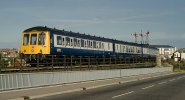I do wonder. but don't have any inside knowledge, if there was some commonality between the body components of the 116/117/118/121/122 DMU family and those of the Mk1 non-corridor coaches, which at least look to have similar widow sizes.
As I understand it ...
The WR used the Derby suburban design drawings quite extensively, except for their own Swindon-design class 120. It's a bit difficult keeping up with the TOPS class numbers, as they are in anything but construction order, but whatever. The 116 were the original Derby suburban cars for the WR, in fact just a variation on the first steel cars, the 50000 Class 114, same body construction and length but with suburban layout and doors etc. Derby ran two production lines side by side through the dmu build era, the short frame, alloy body, low density cars, and the long frame, steel body, high (normally) density ones. Both types had the same cab ends (fibreglass, I believe). Later the cab changed a bit with the repositioning of the destination, and the high level 4-character indicator.
When it came to dieselising the WR London services, Derby was fully occupied, so Swindon sent the Derby drawings to Pressed Steel in Glasgow for the 117s. Pressed Steel had not done dmus before, although they did quite a lot of Mk 1 hauled stock and vans, and so Swindon guided them. They had nicer interiors, including toilets in the trailers. Then again another 15 sets were needed at Plymouth, and the diagrams were sent again to Birmingham RCW, the 118s, the same ones presumably as they are notably difficult to tell apart, and quite different to anything else BRCW did.
The single cars (and their associated driving trailers) were the 122s by Gloucester RCW, these came first, done alongside the comparable Gloucester Cross-Country 119s (which themselves were built from the Swindon Cross-Country 120 drawings, with the Derby cab); Gloucester had been a longstanding Swindon subcontractor, and indeed had built the later GWR single railcars in 1940. However they were a suburban interior. Goodness knows why it was thought that a service that only ran to a single car needed maximum density seating. The 121s came later, from Pressed Steel, and again were just a permutation of previous drawings. It's a strange point that the only dmus on the WR, coming from multiple builders, which did not have the Derby front were the Class 120 units built by Swindon themselves. Nor would the WR have any truck with low density, lightweight cars.


